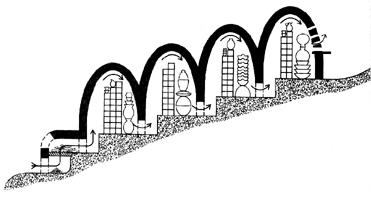
Multiple Chambered, Climbing Kiln
of Chinese Design
ART 198 - HISTORY OF WORLD CERAMICS
| This is a diagram of the kind of kiln used by Chinese potters to obtain the temperatures necessary for stoneware and porcelain. Early versions of this kiln were seen in Han and Tang times, but it was during the Song dynasty that the technology was refined and perfected. This kiln utilized the basic arched format of the beehive kiln, but multiplied the chambers so that total kiln capacity could be increased. This modification worked well in villages where pottery making was the primary activity, and where a large volume of pottery needed to be fired at once. Notice in the diagram below how each chamber has the arch construction typical of the beehive, but that the chambers are joined so that the draft passes through from one chamber to the next. After the kiln is loaded, the fire is lit in the bottom chamber's firebox. The heat rises through the first chamber, and rather than passing out the flue at the top of this chamber, notice how the heat is cycled down and into the opening at the base of chamber number two. After the first chamber has been fired to its ultimate temperature, the potters begin stoking firewood into the firebox at the base of chamber two. The heat follows the same circuitous path as before, rising, then falling, and entering the base of chamber three. This process is continued until all chambers have reached temperature. Notice that the draft of the kiln is eventually up, even though along the way it has taken several downwards turns. Such a kiln is referred to as a DOWNDRAFT kiln, even though the ultimate draft is UP. It is the observation that the draft is DOWN during part of the cycle that causes this kiln to be called a DOWNDRAFT. The biggest disadvantage of this kiln design is that large quantities of pottery are required to fill these huge kilns, making it an impracticable design for the individual potter. This is, of course, its big advantage also: large quantities of work can be processed at once, making it ideal for pottery communities. As mentioned earlier, this kiln was first built in China, probably to increase the volume of pottery available for trade. However, a significant difference in these kilns is that they were able to reach higher temperatures than any kilns before. The recycling of waste heat, the increased thickness of the walls necessary to reinforce these huge chambers, and the multiple fireboxes all combined to cause higher temperatures to result. It was in such kilns that the earliest stoneware and porcelains were developed. Over time the art of porcelain manufacture was perfected by the Chinese potters and held secret for over 700 years. These kilns were huge, often 10-12 chambers, and therefore difficult to conceal. Eventually neighboring villages began to copy the design, and the concept spread out of China to Korea, Japan and ultimately the West. However, by the time this idea traveled to the United States, pottery villages were all but extinct, their role supplanted by machine-made pottery. One additional interesting feature of this kiln is the use of saggar boxes, which were used to protect the pottery from flying wood ash. These saggar boxes, which were made of clay, are indicated in the diagram as the square boxes stacked in each of the chambers. Without these protective boxes the pottery would have been subject to attack by the wood ash, which at these higher temperatures would form glaze and stick pieces together. |
Multiple Chambered, Climbing Kiln of Chinese Design |
|
|